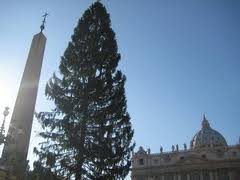 My mother and the neighbors have had the Christmas tree up for a week. We've got three small trees. In fact, my neighborhood is alighted with Christmas lights. New York's Rockefeller Center Christmas tree was lit last week with several stars entertaining us with "Christmas songs." The Vatican put its Christmas tree, a gift from the good people of Bolzano, Italy (a German speaking of Italy where Pope Benedict has vacationed in the past) A little too early for my tastes. SO, it MUST be Christmas time!!! What does it all mean? But what does the Christmas tree stand for? How ought the Christmas tree be interpreted by the Catholic?
My mother and the neighbors have had the Christmas tree up for a week. We've got three small trees. In fact, my neighborhood is alighted with Christmas lights. New York's Rockefeller Center Christmas tree was lit last week with several stars entertaining us with "Christmas songs." The Vatican put its Christmas tree, a gift from the good people of Bolzano, Italy (a German speaking of Italy where Pope Benedict has vacationed in the past) A little too early for my tastes. SO, it MUST be Christmas time!!! What does it all mean? But what does the Christmas tree stand for? How ought the Christmas tree be interpreted by the Catholic?The Christmas tree began as a reminder of the tree of life and the life-giving cross of Jesus Christ. When you see the evergreen Christmas tree you will also see the life-giving tree of life on which Jesus hung as our crucified savior.
For those interested, a short history is helpful.
Many writers derive the origin of the Christmas tree from the ancient Yule tree or from other light and fire customs of pre-Christian times. These explanations, however, are based on mere guesswork and do not agree with the historical facts. It is true that people used to put up evergreen trees in their homes at Yule time, both in pre-Christian centuries and later, to reassure themselves that nature's life was not altogether dead under winter's ice and snow, and that spring would come again. The little evergreen tree in the home, staying bravely alive through the period of nature's 'death,' was a cheerful token and symbol of this assurance. The Yule tree had no direct pagan connotation, and never acquired any Christian religious meaning in later times. Decorations are alien to its symbolism, for its whole significance consists in remaining alive and green during the winter.
Yule trees may still be found in some areas of central Europe, standing side by side with the Christmas tree in the homes of rural districts. Their symbolism has remained entirely separate and sharply distinguished from that of the Christmas tree. In fact, there is the general custom of putting up fir trees, without any decorations, in halls and even churches at Christmas time. These fir trees are not, of course, 'Christmas trees'; but they are used at Christmas to make homes and hall and churches look more cheerful than at other times. They --and not the decorated Christmas tree-- are the true descendants of the ancient Yule trees.
Surprising as it may seem, the use of the Christmas trees is a fairly recent custom in all countries outside of Germany, and even in Germany it attained its immense popularity as recently as the beginning of the last century. It is completely Christian in origin. Historians have never been able to connect it with ancient Germanic or Asiatic mythology. Its origin is due to a combination of two medieval religious symbols: the Paradise tree and the previously described Christmas light [to be noted here on the Communio blog later].
From the eleventh century on, religious plays used to be performed in churches or in the open in front of churches. One of the most popular of these 'mystery plays,' as they were called, was the paradise play. It represented the creation of man, the sin of Adam and Even, and their expulsion from Paradise. This play closed with a consoling promise of the coming Saviour and of His Incarnation. For this reason the Paradise play was a favorite pageant in Advent.
The Garden of Eden was indicated by a fir tree hung with apples, from which Eve broke the fruit and gave it to Adam to eat. This 'Paradise tree' attracted the attention of all, especially the children, since it was the only object on the stage.
During the fifteenth century the mystery plays were gradually forbidden because abuses crept in. The people, however, did not want to miss the Paradise tree. Since they could no longer see it in church, they started putting it up in their homes once a year, in honor of Adam and Eve on their feast day, which is celebrated December 24. The Latin Church has never officially celebrated Adam and Eve as saints, but the Eastern Churches do so, and from the East the custom came into Europe of keeping their feast. Thus, on December 24 one could see the Paradise tree in the homes of the faithful in various sections of Europe. It was a fir tree hung with red apples.
Under the influence of medieval religious 'mystery' pictures, the Paradise tree stood not only for the 'Tree of Sin' but also for the 'Tree of Life' (Genesis 2:9). As such, it bore, besides the apples (fruit of sin), wafers representing the Holy Eucharist (fruit of Life). These wafers were later replaced by little pieces of pastry and candy representing the sweet fruit of Christ's redemption. (FX Weiser's Handbook of Christian Feasts and Customs, p. 98-99).
Watch a brief video clip from Rome Reports...


Leave a comment